
As mentioned previously, the 21st century will be the century of old age, where declining birth rates meet longer life expectancies.
This ageing of the population will affect many areas of the international economy, from consumption and growth to asset valuations.
The impacts from ageing will likely be most acute in Western Nations, although some developing countries, most notably China, will also be negatively affected.
Over the past 25 years, the global economy has benefited from a demographic ‘sweet spot’, whereby there has been a high proportion of working age people supporting only a small pool of dependents.
This ‘sweet spot’ has come about from two main factors:
- The Baby Boomer generation – defined by the Australian Bureau of Statistics (ABS) as those born between 1946 and 1965 and comprising around 25% of Australia’s population – has been at working age; and
- Declining birth rates from the mid-1970s.
This fall in the dependency ratio – defined as the ratio of the non-working population, both children and the elderly, to the working age population – is clearly evident by the below chart showing dependency ratios in key Western Nations.
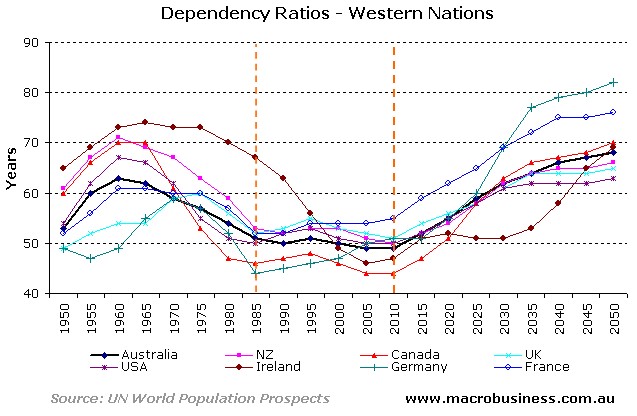
With a large number of workers supporting a relatively smaller pool of dependents, the global economy’s growth potential was maximised between 1985 and 2010.
However, 2011 marks the year when the oldest members of the Baby Boomer generation – those born in 1946 – turns 65 and reaches official retirement age. From now on, each year that passes will witness a marked rise in the number of retirees and an increase in the dependency ratios of Western Nations (and China) and will, other things equal, act to reduce the global economy’s potential economic growth as well as weigh on asset values.
At the same time, the working age population will likely have to wear the burden of increased taxes in order to cover the health care, pension, and other costs relating to an ageing society.
Over the past two weeks, two media reports have shed some light on the challenges faced from an ageing population.
An article published yesterday in Caixin (h/t Bernard Hickey) warns that China’s population is starting to age rapidly, and that this ageing will cause growth to slow unless China can re-balance its economy away from production and toward consumption.
China’s population is getting older, and that could have a major effect on the nation’s economic prosperity.
The emergence of negative growth in the total working-age population, which some demographers predict will happen as early as 2013, is likely to contribute to slower economic growth and higher inflation, according to analysts…
The latest census data, released by the National Bureau of Statistics on Thursday, showed that the proportion of the population aged between 0 and 14 fell to 16.6 percent in 2010 from 22.9 percent in 2000. Meanwhile the number of people aged 60 and above grew to 13.3 percent from 10.3 percent.
The falling number of young people suggests the Chinese population is aging rapidly. The Asian Development Bank forecast that the proportion of those aged 60 and above is expected to rise to 33 percent by 2050. That would make China’s population the same age as Denmark’s, but older than that of the United States (26 percent)…
The potential emergence of a labor shortage is likely to contribute to slower economic growth in the short term,” said Zhang Juwei, professor and director of the Labor and Social Security Research Center at the Chinese Academy of Social Sciences.
China has already reaped the benefits of a demographic dividend, which is believed to have played a role in the country’s economic breakthrough, having enjoyed the advantage of abundant cheap labor for decades.
“Wage increases are the most direct response to labor shortages. That will definitely squeeze the profit margin for some low value-added manufacturers,” Zhang said.
Economists said that higher wage rates could lead to higher inflation and a decline in the competitiveness of the manufacturing sector, which may cast a shadow over the country’s position as a global manufacturing center.
I discussed China’s demographic challenges in China’s demographic time bomb. In a nutshell, China’s economy has until now benefited enormously from its ‘one child policy’, which was brought into effect in 1979 and is credited with preventing around 400 million births from 1979 to 2010. This policy initially produced a population pyramid optimal to economic growth – that is, where the largest segments of the population were neither young nor old, but in the middle (i.e. working age).
This relationship is shown in the below chart, which maps China’s dependency ratios. As you can see, the precipitous fall in China’s birth rates from the mid-1970s caused a sharp fall in the dependency ratio which, other things equal, increased China’s growth potential.
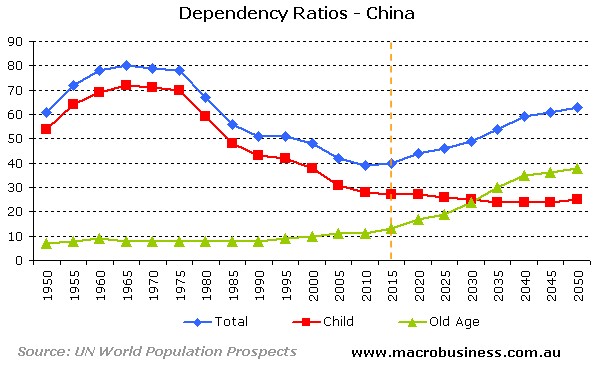
However, the demographic blessing provided by the one child policy is beginning to turn into a curse. As China’s population ages, an inverted pyramid is beginning to develop, whereby too few workers might be left supporting an army of retirees.
Over the next two decades the retired segment will grow rapidly, with those aged over 60 years doubling to around 24% of the population (see below chart).
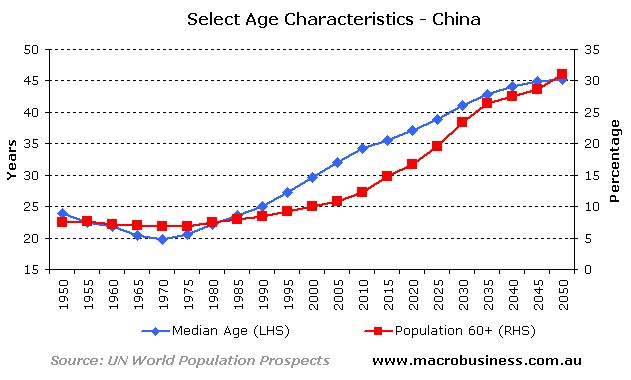
To date, China’s economic model has been based largely on its abundant and low-cost supply of labour, which has enabled it to become ‘manufacturer to the world’ as well as build the infrastructure that has transformed it into the world’s second largest economy. However, the gradual reduction of labour supply, stemming from its ageing workforce, could eliminate China’s traditional comparative advantage in the cost of labour, possibly resulting in it losing its manufacturing base and/or exporting cost-push inflation abroad.
This brings me to a recent article published in the New Zealand Herald entitled Nation at mercy of age crisis, which warns about the potential costs to the New Zealand economy from the retirement of the Baby Boomer generation.
New Zealand authorities and businesses need to wake up to the looming crisis posed by the retiring baby-boomer generation, a university demographer says.
Professor Natalie Jackson says the downstream effects of New Zealand’s baby boom will be more severe than in most other countries.
The post-war population burst was much greater here than in other places – New Zealand’s baby-boom birth rate was 4.2 births per woman, compared with Australia’s 3.6.
Added to that, the baby boomers were living much longer than anticipated and New Zealand had suffered a “bite” out of its 20- and 30-something population thanks to migration…
In five years, 19 per cent of people would be of retirement age and costs such as superannuation and healthcare would place an impossible tax burden on the young, she said.
“No one really imagined a world where we would have 20 per cent of the population over the age of 65.
“By 2023 there will be more elderly than children. Then it’s a short stop to having more deaths than births.
“Once your age structure turns upside down the potential for growth is gone.”
Businesses and government agencies tended to focus only on the particular demographic that affected them, the University of Waikato academic said. “But the whole age structure is the story … There is a crisis unfolding.”
New Zealand’s ageing ‘problem’ is illustrated in the below chart showing how New Zealand’s total dependency ratio is projected to worsen gradually as the baby boomer generation enters retirement.
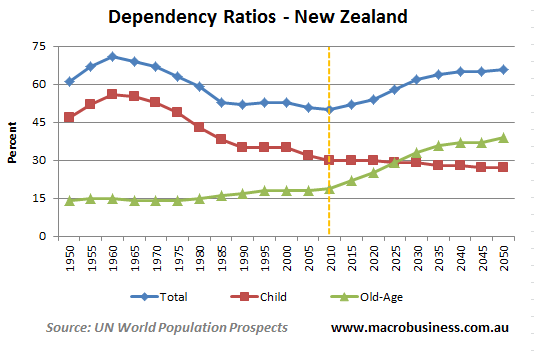
New Zealand’s demographics are actually very similar to Australia’s. While its birth rate – at 2.1 births per woman – is higher than Australia’s (1.9) and relatively high by OECD standards, its immigration rate is just above the OECD average, but lower than Australia’s (see below chart).
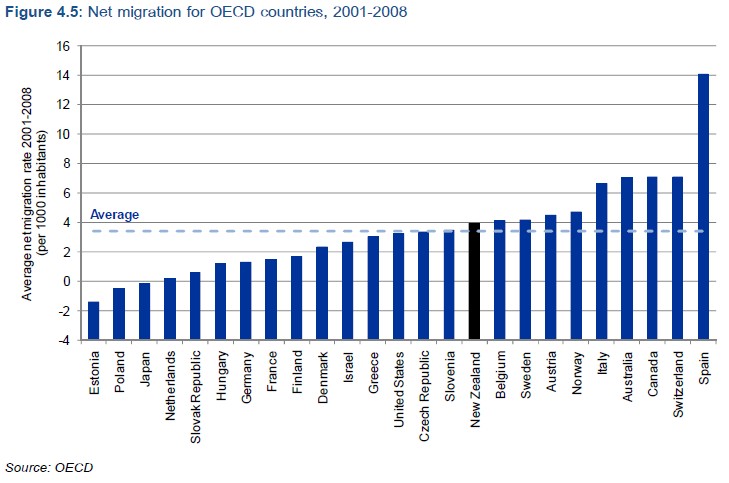
To illustrate the similar age profile of the two countries, I have charted the total dependency ratios for Australia and New Zealand.
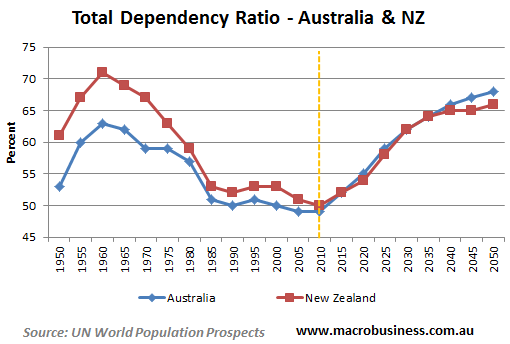
Not surprisingly, then, both nations will face similar demographic headwinds as their populations age and the proportion of working age people declines, bringing with it lower consumption expenditure and growth, as well as higher taxes.
And the impact of ageing on asset prices are expected to be substantial. For example, according to a recent Bank for International Settlements (BIS) working paper, the ageing of the Baby Boomers is projected to reduce Australia’s (New Zealand’s) real house price growth by around 30% (40%) over the next 40 years compared to neutral demographics. This is because the Baby Boomers will reduce their housing stock as they enter retirement by liquidating their investment property holdings and downsizing, thereby depressing house prices (see below chart).
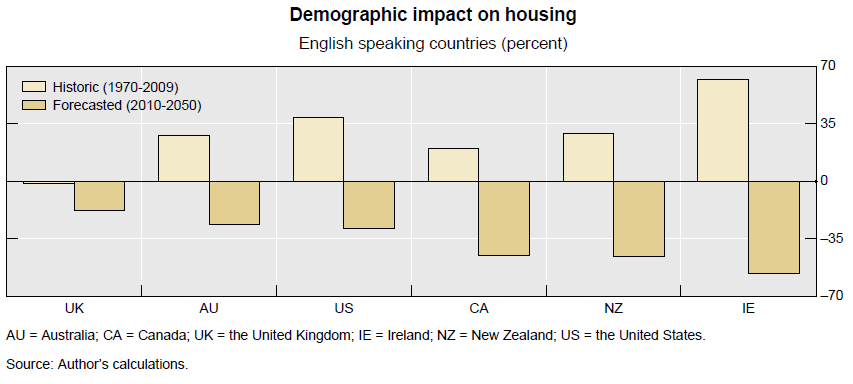
Demographic shifts are inherently slow moving, so the impacts from an ageing society will likely be gradual and may go unnoticed for an extended period of time. Nevertheless, these longer-term challenges are significant and are likely to alter the path of the global economy in the decades to come.
It, therefore, pays to consider changing demographics when planning any long-term investments.
Cheers Leith

